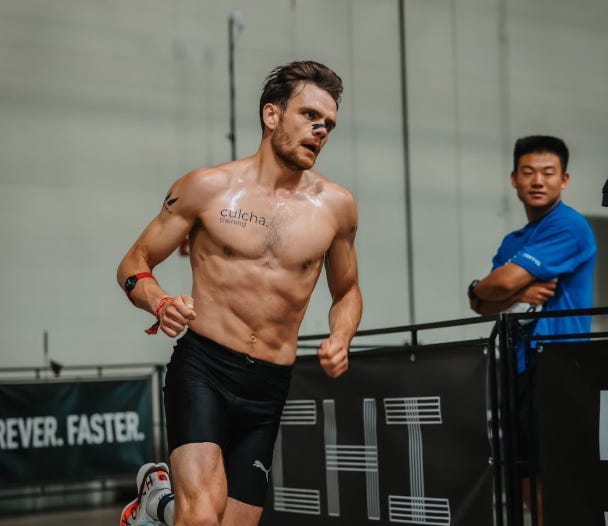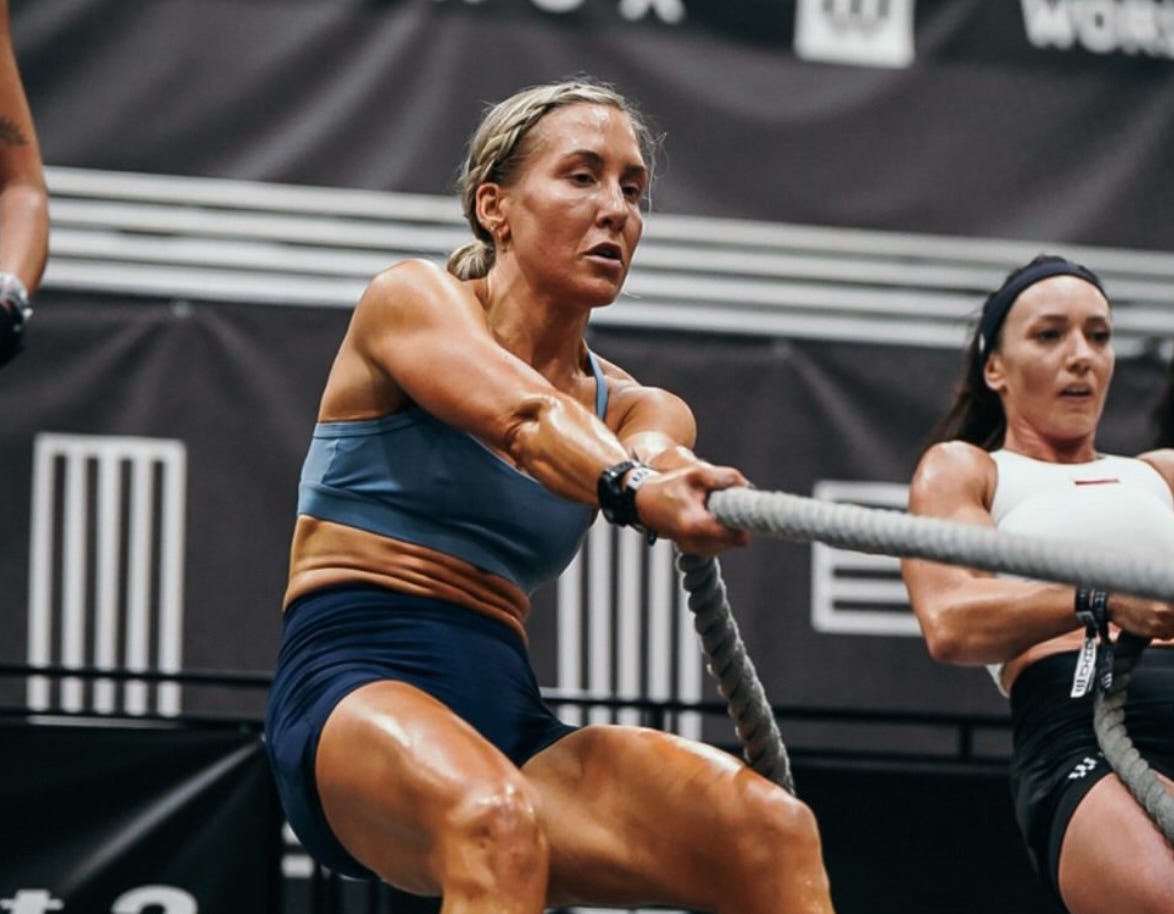How to win the Hyrox World Championship
Tim Wenisch didn’t just win the Hyrox World Championships in Chicago this past June—he seized the title with a bold, all-or-nothing approach, tearing through the course in 53:53. Not content to rest on that triumph, Wenisch returned just two days later, partnering with Jannik Czapla for the Elite Doubles race and conquering the field with a 50:24, outpacing rivals who had banked on fresher legs.
It was an electric weekend that took many by surprise, coming after a season shadowed by injury and the frustration of dropping out of last year’s Elite 15 race in Nice. Wenisch, who once abandoned the village running track for friendship and football, now thrives on the pain and pressure of racing at the absolute limit — trained, as he puts it, to “feel cozy in the red zone.”
The Hybrid Letter sat down with Wenisch to unpack the lessons he’s learned in the unforgiving world of hybrid competition, his fiercely aggressive race strategy, and the ruthless mindset that propelled him from provincial track talent to the new world champion.
This interview has been edited for length and clarity.
The Hybrid Letter: Let’s start at the beginning: Tell me about your background in sports.
Tim Wenisch: I grew up in a small village near the Alps—very close to nature. As a kid, I played football and tried all kinds of sports: tennis, skiing, biking. Later on, I stuck with football, and my dad noticed I had a knack for running. That led me to join our village’s track and field club. I raced 800m and 1500m, and eventually made it to the German youth national championships for the 3000m when I was about 15 or 16.
Balancing school, sports, and friends was tough. Coming from a small village, I lost friendships because running kept me away on weekends; my friends were off partying, while I was competing. By 18, I stopped running—I just wasn’t happy. I rejoined the local football club and spent a few years reconnecting with friends and enjoying those relationships.
After a while, I needed something new. At the gym one day, I came across a German magazine called Fit for Fun. There was an article about a sport called CuRox—before it was renamed Hyrox. I wanted a new goal, wasn’t satisfied just running. I had tried CrossFit, but the focus on strength didn’t suit me. I missed competitions, so I signed up for my first Hyrox race in Hamburg in 2018. From then on, I was hooked.
THL: What was it about your first Hyrox race that made it stick?
TW: My first race was intense. I weighed only 63kg, which is light, and I chose the Pro category. It was tough—the lanes were 25 meters, so the sled pulls were brutal. But Hyrox was the first sport that brought together everything I loved training. That mix was addictive.
THL: How did your training shift once you committed to Hyrox?
TW: I had to add a lot of station work. The compromised running was also something I wouldn’t normally do because why train running on heavy legs when you want to just get faster. It doesn’t make sense. But those were two things I had to implement in my training.
THL: You’ve had to push through some injuries in recent seasons. Can you talk about that?
TW: Both injuries stemmed from pushing too hard. I developed a bone marrow edema in my hip—too much intensity, especially when paired with running. With all the impact on tendons and bones, it added up. My big mistake in 2023 was running 100km a week alongside tough workouts. I learned I can’t maintain that high volume with station work and heavy-impact strength.
Once my hip healed, I ended up compensating, which led to an injury in the other hip. I started getting cortisone injections, and that’s when I discovered my blood is a bit thicker—I developed thrombosis 10 days before Worlds in 2024. Now, I always wear compression socks.THL: What did you change this year to keep injuries at bay?
TW: I realized I can’t keep raising both volume and intensity. I started prioritizing recovery. If my recovery’s faster, I can handle intensity better. I now see a physiotherapist twice a week for mobility and keep my run volume lower. My weekly mileage is capped at 80 or 90km, and I add bike volume instead.
THL: Did scaling back your training mean sacrificing anything?
TW: Reducing my running mileage let me ramp up my strength work. Running is tough on your whole body, especially tendons; biking gives great aerobic stimulus without the impact. The key is hitting my threshold and speed workouts each week. Those sessions are vital; the rest of the week, I keep it easy.
THL: Has charging out front always been your strategy at big races—like Worlds?
TW: I run in that way because I want to win. But a little deeper than that, I don’t want to change anything because I started Hyrox to have fun. When I am on the start line, I want to give everything I have that day. That is why I am so aggressive. I always say all or nothing because I don’t race for a place, or for money, or for my sponsors. I want that feeling when you cross that finish line in the first position. That feeling is addicting.
In Chicago, I started fast because my running was at its peak. If I push the pace, others are forced to keep up and often overpace themselves. It’s risky, but at Worlds, it was my best strategy. Plus, it’s a way to show confidence—to prove you’re ready to suffer and really race.
THL: How do you train for living on that edge—the “red line”—but not going over it?
TW: I train a lot of compromised running at 90-95% of my max heart rate. You have to be comfortable in discomfort and want to step into that red zone. Once you’re there, you have to learn to feel cozy. You remind yourself not everyone can stay in that zone—it’s so painful. If you want to win, you have to learn to suffer.
At this level, you have to be a little crazy. For me, it’s all about mindset.
THL: Are there mental tricks you use to stay sharp during a race?
TW: The most important thing is to be present. In the past, I'd get lost thinking about the next station or the next run. Now, I train my mind to stay exactly where I am—focused on the current moment.
THL: Let’s talk about those wall balls at Worlds, when Hunter started gaining on you—what was going through your mind?
TW: I didn’t realize how tight it was until I watched the recap. When I got to wall balls, I was surprised to see Hunter arrive when I was at about 20 reps. You start calculating in your head—20 wall balls is about 40 seconds. I figured with a four-minute wall ball station, I'd have enough time.
I expected Hunter would take at least one break; I didn’t plan for him to go unbroken. Seeing his rep count climb, it was tough to stay relaxed. My own wall balls are usually very clean, but the risk of a couple no-reps grows when you get nervous or tired. That’s why, toward the end, I took a few very short rests. Ultimately, it came down to five seconds to claim the World Champion title. Next time, I’ll make sure to go unbroken to be safer.
THL: In Elite Doubles with Jannik, you picked up a couple of time penalties during burpees. How did you adjust your strategy?
TW: The penalties hit hard. At first, we thought a 30-second penalty could drop us several places. But we saw other teams getting penalized, and just went flat out. We built a gap—especially after Kent and Rylan made mistakes on the farmers' carry. That’s when we realized we actually had a shot at winning.
It was a real surprise. There were so many strong teams in doubles, including athletes who hadn’t raced in other events that weekend. Our time wasn’t exceptional; I think a lot of athletes were simply sore and tired. It ended up being our day.
THL: What’s your top priority for next season?
TW: Unbroken wall balls—and more confidence in wall ball wars. That one change will define my whole race, because that station is always on my mind. If I’m more confident with wall balls, I can run faster, hit stations harder. I still hold back, sitting at 80-90% out of respect for that final station. In Chicago, I didn’t go all-out because I knew I had to survive a war with Hunter looming behind me.
I’ll practice wall balls a lot, and with the help of my coach, aim to go unbroken. That’s the key to racing faster overall.
THL: When does your new season start?
TW: My next race will be the major in Maastricht. Elite Doubles qualification works differently, so my first big race for that will be in Hamburg. It feels far away, but it isn't. I always tell my sponsors that I need at least 10 solid weeks of preparation. For me, that meant starting up at the end of July. It happens quickly.
You can follow Tim on Instagram
Science corner: Embrace the heat
It is the dog days of summer in the Nestern Hemisphere, which means hybrid athletes who want to train outside are subjected to hot and humid conditions. One option is to take refuge in an air-conditioned gym. But research shows that exposing yourself to heat can improve your performance even if you are ultimately racing indoors.
A study of cyclists found that 10 days of intentional heat exposure (training in 104°F or 40°C) improved V02 max and lactate threshold in cool conditions by 5%. This represents significant gains in the key metrics that impact performance in endurance sports. The physiological impact is similar, although not quite as pronounced, to training at altitude. To adapt to the heat, your body creates more blood and red blood cells.
Experts recommend starting with 30 minutes of heat exposure at a time and focusing on staying hydrated.
Athlete of the Week: Samantha Snukis
Name: Samantha Snukis
Age: 39
Hometown: Saint Clair, PA
Current Town: Lititz, PA
When did you start hybrid training? I officially started hybrid training in January 2025, but in a way, it began years earlier. My brother used to put me through what we now call hybrid workouts—tons of burpees and farmer’s carries. I thought he was crazy at the time! He was ahead of the curve, doing CrossFit-style training before it really caught on in our area. After racing professionally as a triathlete since 2019, I found myself craving something new. I needed a break from the triathlon routine, and Hyrox offered the perfect challenge to reignite that competitive spark.
Favorite race to date? I’ve only raced twice so far, but I’d have to say my first race—the North American Open Championships in Washington, DC. It was such an amazing experience and so much fun. First races are always special!
Race goal? My goal is to PR in both the PRO and OPEN categories. I don’t have a specific time in mind—any improvement is a win.
Favorite station? All the ergs! I’ve got a strong running base, which helps, and being tall with long levers definitely works to my advantage.
Least favorite station? BBJ—gross. I need a lot of work there.
Things you wish you knew when you started racing? Strength is a huge part of Hyrox racing. You can be one of the most accomplished runners, but that doesn’t always mean you’ll rise to the top of the Hyrox field.



